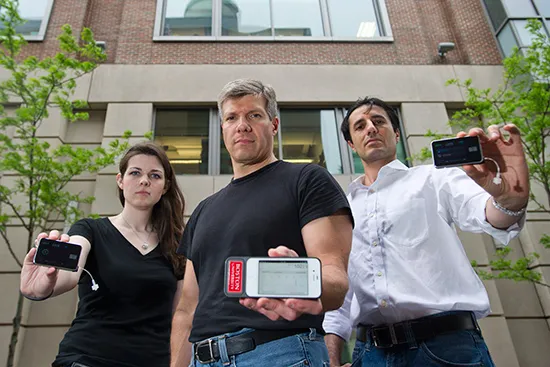One of the most anticipated advances is to find a perfect spare to the organ in charge of insulin production.Thus, the artificial pancreas could be ready in the short term, as their US creators express.
The Personal Project of Edward Daminano, professor of the Department of Biomedical Engineering at Boston University (USA), is born from the need to provide a therapy to his own son who suffers from type 1 diabetes since his birth.
When they justify the idea of why a bihormonal bionic pancreas, one of its closest collaborators, Edward Raskin, who participates in the "Bionic Pancreas" project, explains that "a way of thinking about the combination in a device of insulin and glucagonIt is to turn it into an easy to understand how the accelerator and the brakes of a car.
Insulin acts as an accelerator and glucagon will be the brake.If a patient's blood is too fast, the glucagon can stop the process, without the patient having to eat anything.It is a very powerful tool that allows better blood sugar control and potentially keeps patients safer due to the reduction of hypoglycemia is largely reduced, and even eliminated in some cases ».
lights and shadows
Currently, this team has completed the requirements of studies in phase II, whose results have seen the light in different scientific journals of the first level "Lancet", "New England Journal of Medicine" or "Science", among others."We are preparing for our last phase III essay, which we hope will begin in the first half of 2017. This is the process that will be used for the approval of regulators, both in the United States and in the European Union," he saysRaskinIn this sense, there are experts who are a bit reluctant because they still see the idea a bit "green."Esteban Jodar, head of the Department of Endocrinology and Clinical Nutrition at Quironsalud Madrid, explains that «the technological revolution is close to giving new treatment options to people suffering from diabetes, but there are options closer over time, such as the ASA of ASAclosed, which offers important advantages ».
The idea of the Damian Bionic pancreas is based on creation a completely personal device for the patient, “which learns and adapts uniquely to each system owner.A small child may need less insulin compared to a growing teenager.The device performs all those adjustments automatically, since it adapts to the user.The only thing that the system has to know at the time of starting is how much the patient weighs.This makes it the definitive solution of personalized medicine ».Here it is worth mentioning another of the "pegas" that this system still has: the algorithms."This is a problem of mathematics, the reliability offeredPrimary of Raval Sud from Barcelona.
Another obstacle is the use of glucagon.Javier Ampudia, deputy doctor of the University Clinical Hospital of Valencia explains that «this compound is quite unstable when used in an infusion bomb, since only its current administration is designed for the taking at the time of its preparation.In a short time, we trust that they find similar solutions that allow the good progress of this system ».Ampudia knows well what is the development of an artificial pancreas - only with a hormone, insulin -, since he participates with Ignacio Conget, researcher at Ciberdem and Idibaps and engineers Jorge Bondía (Polytechnic University of Valencia)and Josep Vehí (POLITIS UNIVERSITAT of Girona), among others.«In our case we try to automatically control the disease with insulin only, but in different aspects.We want to know if we can face the control of sugar at food time;Here we have much more problem, because for an automatic system it is complicated.Another of the situations is when one exercises, which is also difficult, since we study both aerobic and anaerobic sport to be able to translate the algorithm that is generating an organic effort, ”explains Conget.
Expand studies
With this artificial pancreas option, one of the most usual problems in patients suffering from type 1 diabetes is responded: hypoglycemia.It has been successfully tested in adult patients and children at the Massachussets General Hospital, so the next step is the multicenter clinical trials that will be done during longer time spaces (months).Data published in "New England Journal of Medicine" point out that adolescents who tested the bionic system showed a reduction of more than double the number of interventions against hypoglycemia;In addition, patients experienced significant improvement in glucose levels, especially during the night.
«With promising results such as these, we intend to support great multicenter essays of the artificial pancreas in the near future.In the coming years, we hope that these technologies go beyond experimental essays and are available to benefit more people with type 1 diabetes, ”said Guillermo Arreaza-Rubin, responsible for the project for artificial pancreas studies financed by the Institute ofDiabetes and Digestive Diseases and Renal Diseases (Niddk) of the National Health Institute (NIH).More than 10 years have passed from the first tests in the Massachussets Hospital until today, in which the system has ended simplifying until reaching a glucose meter, an iPhone and two infusion pumps (one of insulin and one fromglucagon), all connected via wifi.The system has been called "ilettm", "in tribute to the pancreatic islets of Langerhans, which contain the Lafa and Beta cells that secrete glucagon and insulin, respectively," as Damian manifests.
Thus, the latest data published in "Lancet", last February, mentioned the improvements in glycemia and the reduction of hypoglycemia.The trial collected five -day data in which the bionic pancreas with the insulin pump was compared in 19 children, aged between 8 and 9 years.Both in conventional hair glycemia measures and those obtained through continuous monitoring, data favor artificial pancreas.«The debate we have now is whether unihormonal or bihormonal, or both and that it is the patient's profile that is the decision maker.The important is that we have the solution, which will arrive in less than five years, and that this can be real for patients, ”concludes Cognet.
Other significant advances
Waiting for the artificial pancreas, patients currently have a very complete arsenal, «which has been revolutionized in the last five years.The treatments do not follow a rigid line based on the stimulation of insulin production, ”says Franch Nadal."We live a prodigious decade in the treatment of diabetes that we hope helps us normalize and make the lives of people with diabetes more," he emphasizes fucking.
In type 1 diabetes, «in addition to the rapid and slow analogues of insulin than we already had, there are new presentations with a higher concentration of basal analogous insulin that prolong their effect andof a novel basal insulin aciled with a mechanism that allows most faithfully reproducing insulin production by the normal pancreas and provides a predictability of its effect and flexibility in the administration schedule that was unthinkable so far and that will be of great helpIn very different clinical situations with which people with diabetes and their doctors are daily, ”explains Jodar.
On the other hand, in the treatment of people with type 2 diabetes, «there has been a true revolution in recent years with the appearance of therapeutic classes: the agonists of the GLP-1 receiver and the SGLT2 collection inhibitors.These avoid hypoglycemia and allow losing weight, especially in overweight patients, ”adds Ampudia.





